Leather stands as a symbol of quality and durability in fashion, accessories, and furniture. Did you know that over 80% of the world’s leather goods come from chrome-tanned hides — a process that finishes in just one day but leaves behind toxic waste that lasts for years?
This single fact shows the hidden side of the leather you wear, sit on, or carry every day. While leather is often seen as a symbol of luxury and durability, its origin, treatment, and quality vary more than most people realize. Whether you’re buying a wallet or investing in a designer bag, what you don’t know about leather grades, tanning methods, or sustainability practices could cost you — not just in money, but in comfort, safety, and environmental impact. This ultimate guide to leather grades, tanning, and care reveals how to choose durable, high-quality leather while avoiding fake leather scams.
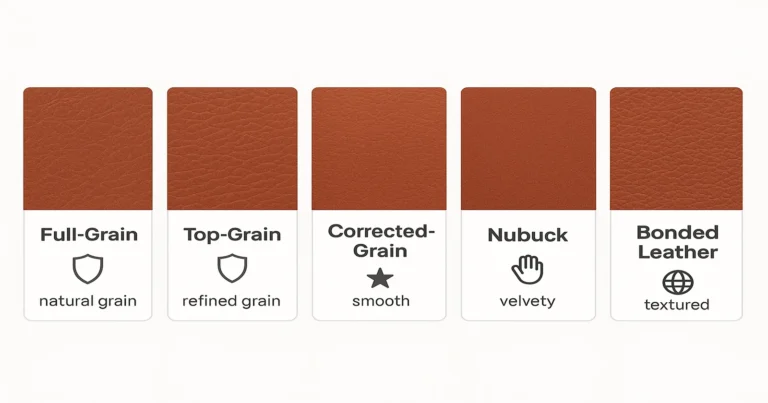
Every piece of leather starts as an animal hide. Leather grades describe the quality of that hide and how much of the natural grain remains. Understanding grades helps you pick leather that fits your needs and budget.

This top-quality leather keeps the entire grain layer. It shows the hide’s natural texture, markings, and pores. Over time full-grain leather develops a patina over time. It resists wear and lasts for decades. Use it for premium products like high-end bags, sturdy boots, and quality furniture. (Example: a classic leather jacket often uses full-grain hide.)
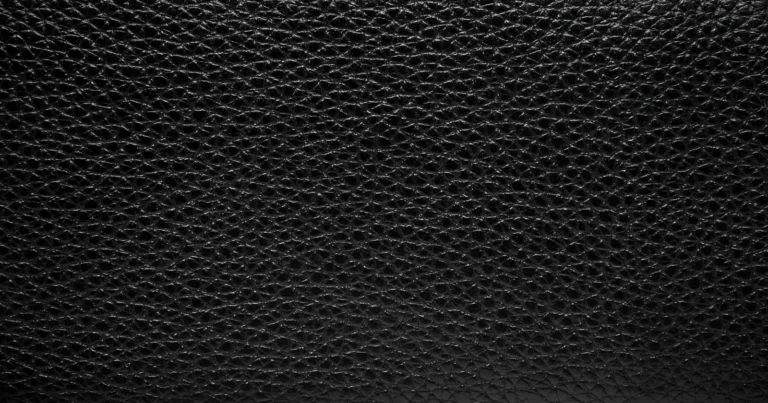
Top-grain leather is the next grade down. It comes from the top of the hide too, but it undergoes light buffing or sanding to remove imperfections. This makes the surface smooth and uniform. Top-grain leather is durable and looks very nice, but it does not develop as much patina as full-grain. It still resists moisture and wear better than lower grades. Many leather bags and furniture use top-grain for a balance of quality and price.
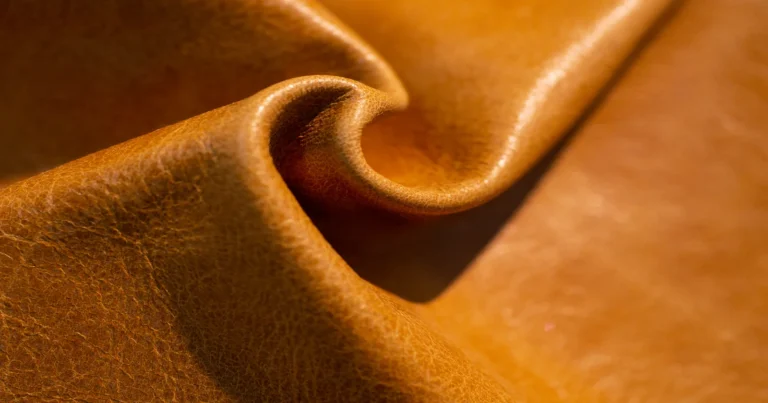
This type starts from full-grain hides that have noticeable marks. Manufacturers sand or buff the surface heavily, then stamp an artificial grain pattern. They add pigment or finish to make it uniform. Corrected-grain leather has no natural imperfections and can be very durable. It resists stains and cleaning better than natural grain. You see corrected-grain leather in many mid-range products and car interiors. (It looks great, but it lacks the true grain feel of full-grain leather.)
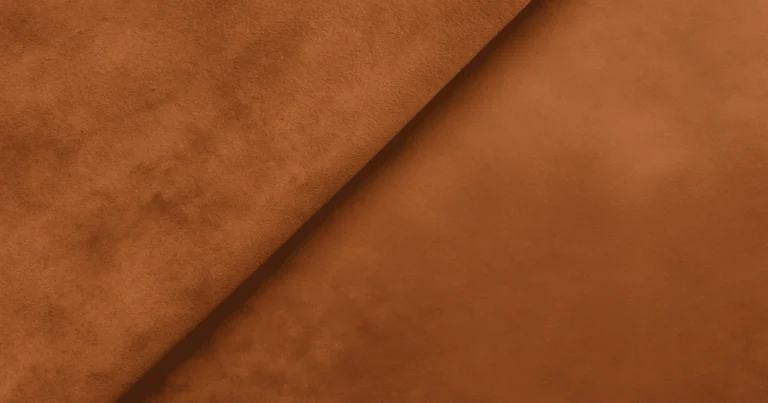
After taking off the top grain, the inner layers of the hide are split off. The split layers have less strength than top layers. If the rough underside is buffed lightly, it becomes suede (short nap) or nubuck (the smooth top grain buffed to a suede-like feel). Split leather is soft and velvety, used for jackets, shoes, and gloves. However, it stains easily and does not age with a patina like full-grain. It feels unique but needs more care and is not as long-lasting.
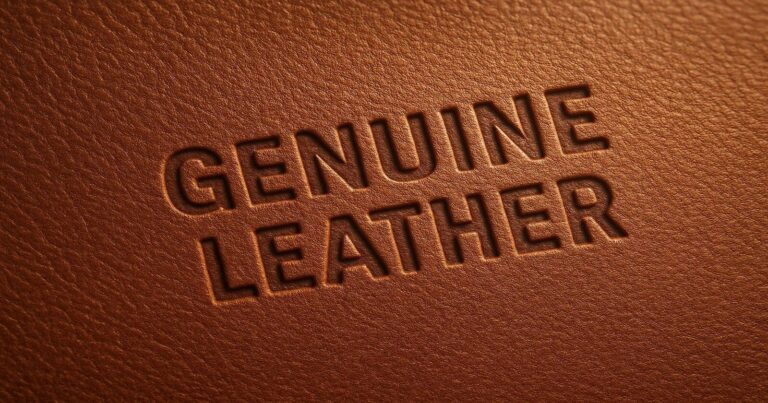
The term “genuine leather” can be confusing. It usually refers to a lower grade made from the lower parts of the hide or from leftover scraps. Genuine leather might be dyed or have a surface treatment. It is still real animal hide, but it is less durable and often thinner than higher grades. Products labeled “genuine leather” are often inexpensive belts or small accessories. They look like leather but can feel stiff or plasticky. They do not last as long and don’t develop a patina.
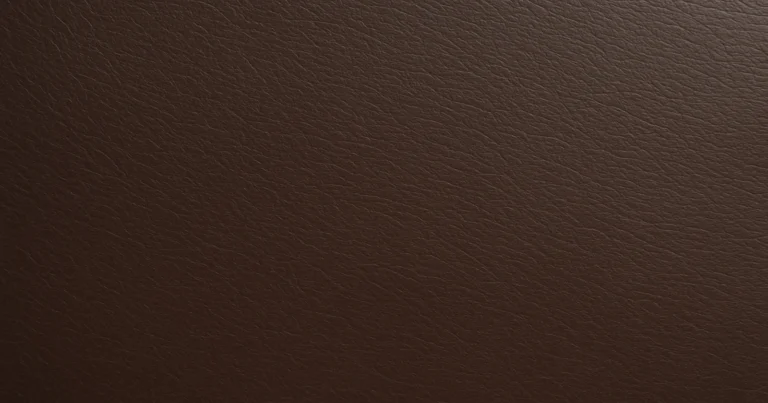
Bonded leather is the lowest grade. It contains small scraps of leather fibers mixed with glue and pressed together, then coated with polyurethane or another finish. Bonded leather looks like leather, but it peels, cracks, and wears off relatively quickly. It is not strong or breathable. Manufacturers use it on cheap furniture or belt loops to lower costs. Real leather feels much different at the edges than bonded leather, which has a plastic-like backing.
| Factor | Full-Grain | Top-Grain | Bonded |
|---|---|---|---|
| Lifespan | 20+ years | 10-15 years | 2-5 years |
| Breathability | ★★★★★ | ★★★★☆ | ★☆☆☆☆ |
| Price (per sq ft) | $25-$50 | $15-$30 | $3-$10 |
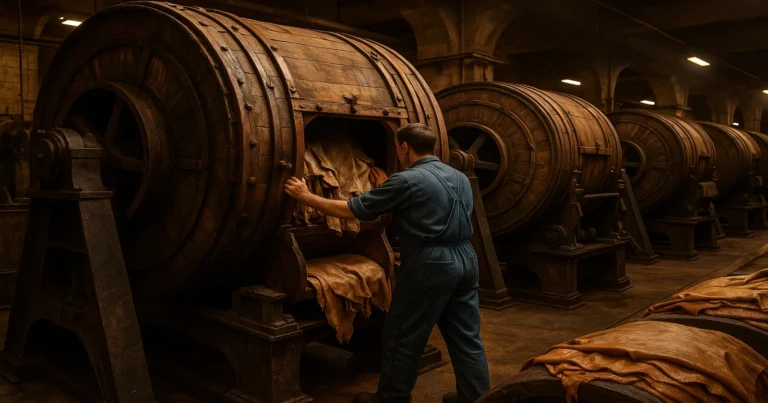
Raw hides need tanning to become leather. Tanning turns perishable skin into a durable, stable material. The process uses tannins or chemicals to bind collagen fibers. There are several tanning methods, each giving the leather different qualities:
This traditional method uses tannins extracted from plant materials like tree bark, wood, and leaves. Leather goes into large pits or vats of vegetable tannins for weeks. The tannins slowly penetrate the hide and stabilize it. Vegetable-tanned leather tends to be firm and rich in color, often brown or tan. It develops a deep patina and feels very natural. The process is eco-friendlier than chemical tanning because it uses renewable tannins and few toxic chemicals. Vegetable-tanned leather is often used for high-end belts, saddles, book bindings, and premium leather goods. It can be stiff at first but softens nicely with use.
This modern, widespread method uses chromium sulfate and other chromium salts. Hide batches go into rotating drums with a mixture of chromium and other agents. Chrome tanning takes only a day or two. The result is very soft, pliable leather that holds vibrant dyes and a uniform color. Chrome-tanned leather is flexible and less likely to shrink. It is used in most mass-market leather products like furniture, car upholstery, and fashion accessories. The downside: it uses heavy metals and chemicals, so factories must handle waste carefully. Chrome leather also doesn’t take on patina as much as vegetable-tanned leather.
This method uses glutaraldehyde or formaldehyde. It creates a white or pale-colored leather. Aldehyde-tanned leather feels soft and is often used for products where softness is key, such as baby shoes, glove leather, or specialty apparel. It avoids chromium but still needs careful handling of chemicals. The leather resists heat and is sometimes called “wet-white” for its pale color.
Other chemicals can tan leather too, such as synthetic tanning agents (syntans) and sulphides. These are often used in combination with chrome or vegetable tanning to improve certain properties. For example, a mix of chromium and plant tannins can produce leather with mixed benefits: soft hand but more natural color.
Vegetable tanning (the most sustainable leather process) uses oak bark tannins that biodegrade 3x faster than chrome alternatives according to LWG 2024 data. Heritage tanneries like Italy’s Conceria Walpier specifically use chestnut tannins for richer color development
Luxury houses like Hermès and Red Wing use vegetable tanning because:
✓ Develops richer patina over time
✓ No toxic chemical residues
✓ Biodegradable end product
The 4-6 week process uses oak bark and other plant tannins, creating firmer leather that softens beautifully with age – perfect for heirloom-quality bags and boots.
After tanning, leather often goes through finishing to achieve the desired color, texture, and protection. Different leather finishes change how leather looks and performs. Here are common finishing types:
Aniline leather is dyed with soluble dyes only, without any surface pigment. The natural grain and texture show through completely. This finish is the most natural looking. The leather feels supple and luxurious, but it stains and scratches easily. Think of a high-end leather sofa or jacket in a rich deep color with no plastic coating. Pure aniline leather has a matte, deep tone. It develops a patina and marks from use. Many leather connoisseurs love aniline for its soft feel and character
Semi-aniline starts with an aniline dye, but then adds a thin protective coat of pigment or clear top coat. This means the leather still shows most of its natural grain, but gains some protection against stains and fading. Semi-aniline leather is a popular mid-point: it feels soft and natural, with only a light sheen. It resists fading and liquid stains better than full aniline. You will find semi-aniline in nicer furniture, car seats, and some apparel.
Pigmented leather has a heavy coating of opaque pigment on the surface. Manufacturers apply a colored lacquer or polymer finish to completely cover the grain. This creates a very uniform color and a glossy or matte surface. The coat hides any imperfections and makes leather highly resistant to stains, UV fading, and wear. Pigmented leather does not develop patina because the finish prevents natural contact. It also feels firmer to the touch. Most mass-market leather seats, shoes, and bags use pigmented finishes. It is very practical – easy to clean and long-wearing – but it lacks the character of natural grain.
Some leathers are stamped or embossed to imitate exotic skins or patterns. For example, plain leather can be pressed to look like crocodile scales, pebbled grain, or quilted designs. Embossing happens on full-grain or top-grain leather with a coating on top. This treatment creates a consistent pattern and can hide marks. Embossed leather is often pigmented or semi-aniline underneath the stamp. It combines style with durability. You might see embossed alligator-pattern leather in fashion handbags.
These are special treatments, often considered finishes. Nubuck is top-grain leather that’s buffed on the outer surface to create a soft, velvet-like nap. It looks similar to suede but is actually from the top layer of hide. Suede is made from the inner split of the hide, also buffed for nap. Both nubuck and suede have a fuzzy surface and matte look. They feel very soft but are highly absorbent and stain-prone. They do not shed color the way pigment hides do. Nubuck and suede usually get sprayed with protective finishes or wax to help protect them.
Shell Cordovan is a rare, high-end leather from horsehide. It comes from a specific fibrous flat part of the hide near the rump. Shell Cordovan is tanned (traditionally vegetable tanned) and then polished until it shines. It has no visible grain and a glossy finish. This leather is extremely durable, smooth, and slightly elastic. It is expensive and used for quality boots and watch straps. Its finishing process is unique and involves a lot of hand-polishing.
Some leathers receive a final coat to make them glossy or to add shine. Patent leather, for example, is cowhide coated with lacquer or vinyl for a mirror-like finish. Others might get a matte topcoat to reduce shine. The finish changes the look: glossy makes colors pop, matte looks more natural. Protective wax coatings can give a vintage or waxed cotton look to leather, often used on jackets and bags for a rustic appeal.
Choosing a finish depends on use. For durability and ease, pigmented leather suits heavy-use items. For natural beauty and luxury, aniline or shell cordovan work best. Embossing adds style without hurting toughness. Nubuck and suede offer a unique texture but need extra care. Always match the finish to the intended function of the leather product.
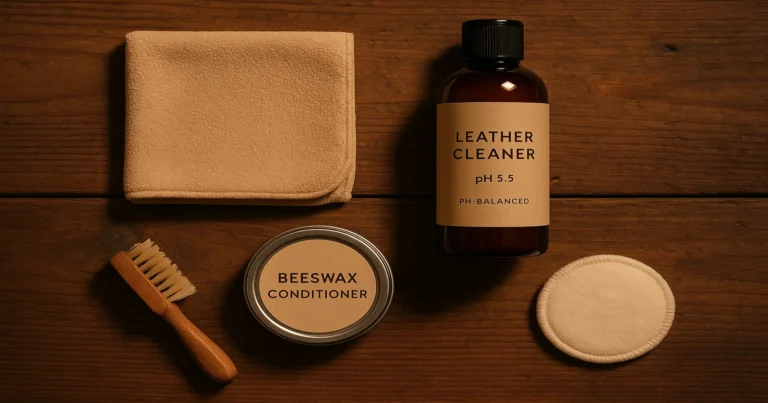
Proper care keeps leather looking its best and lasting longer. Leather is strong, but it still needs attention. Here are steps to clean, condition, and protect leather in everyday life:
Avoid:
Leather can dry out over time, leading to cracks. To keep it supple, apply a leather conditioner or balm every few months (or more often if the leather feels stiff). Use a clean cloth to apply a small amount of conditioner, buffing it into the leather in circles. The conditioner nourishes the hide and restores oils that may have evaporated. Let it soak in, then wipe off any excess. Common conditioners include mink oil, beeswax mixtures, or commercial products designed for leather. Always test a new conditioner on an inconspicuous spot first.
Follow this schedule for optimal care:
| Leather Type | Conditioning Frequency |
|---|---|
| Full-Grain | Every 6 months |
| Suede/Nubuck | Never (use protector sprays) |
| Pigmented | Yearly |
Pro Tip: Condition when leather feels stiff or shows whitish creases – these are early signs of moisture loss.
Leather’s ideal pH is 4-5 (slightly acidic). Common mistakes that disrupt this:
✖ Using dish soap (pH 8-9) – strips natural oils
✖ Applying vinegar solutions (too acidic at pH 2-3)
✓ Best practice: pH-balanced leather cleaners like Lexol (pH 5.5)
A simple test: If water beads up instead of absorbing, your leather’s pH is off and needs rebalancing with a proper conditioner.
After cleaning and conditioning, consider adding a protective layer. There are leather waterproofing sprays or waxes that create a barrier against moisture. This is especially useful for shoes, jackets, and furniture. Apply according to instructions, usually in a well-ventilated area. Protective finish helps repel water and guards against stains. Keep leather out of direct sun and away from heat sources (like radiators), which can dry it out and fade colors.
Act quickly on spills. Blot liquids with a clean cloth (do not rub). For oils, sprinkle cornstarch or baking soda to absorb, then brush off after a few hours. For ink or dye stains, specialized leather cleaners can help, but these can be tricky. Always follow product guidelines. For tougher stains, consider professional leather cleaning. Never toss leather in a washing machine or use petroleum-based cleaners.
Store leather items in a cool, dry place. Hang jackets on padded hangers to keep shape. If storing leather boots or bags for a season, clean and condition them first. Keep covers or dust bags loosely draped over them (do not wrap tightly in plastic, which traps moisture). Make sure the storage area is dry; mildew grows in damp, dark spots. If leather gets wet, let it air dry naturally away from direct heat.
Adjust care by season. In winter, indoor heating can dry leather, so condition more frequently. In summer, protect leather from sweat and humidity by wiping it after use and letting it air out. If leather is left in a hot car, it may warp or crack; keep it shaded. Leather jackets may benefit from dehumidifiers in humid climates to prevent mold.
You can make a simple conditioner at home. A common recipe is equal parts olive oil (or another natural oil) and white vinegar. Mix well and apply a small amount with a cloth, then buff. The oil feeds the leather and the vinegar cleans. Use sparingly, as too much oil can darken or soak into leather. Store homemade mixtures tightly sealed.
Keep leather away from sharp tools or animals that might scratch. Even though leather is tough, a single deep scratch or puncture is hard to repair. Using protective covers or placing furniture out of direct traffic routes can prevent accidental tears.
Leather cleaners have specific PH levels that are safe for leather. Use a pH-balanced cleaner and condition every 3–6 months to prevent cracks. Many consumer leather cleaners maintain a balanced pH to avoid drying. Avoid household cleaners like dish soap or laundry detergents, which can alter the leather’s pH and damage it.
Regular care pays off. Cleaning removes dirt that can abrade the surface. Conditioning prevents dryness that leads to cracks. Small efforts keep leather soft and prevent major damage. Over time, your well-cared leather will reward you with beauty and strength.
Knowing how to tell genuine leather from imitations helps you avoid poor quality. Fake leather (often called faux leather, PU, or pleather) uses plastics. Here are quick tests and clues:
Real leather has an uneven, natural grain pattern. You see small pores or scars from the animal’s life. Faux leather often has a perfectly consistent texture or repetitive patterns. If it looks too uniform, it is likely synthetic.
Inspect the cut edge. Genuine leather has fibers and sometimes layers visible. It looks like rough fabric, especially at the very edge. Fake leather (PU or vinyl) has a smooth, plastic-like edge. Bonded leather will have a very uniform edge because it’s compressed scraps.
Leather has a distinct smell – earthy, rich, and slightly sweet. Fake leather often smells like plastic or chemicals. If the item has a strong factory or chemical odor, it is likely synthetic. A slight leather scent usually means real hide, though some high-end synthetics may add a leather-like fragrance.
Genuine leather feels warm and flexible. It may wrinkle slightly when pressed. Faux leather feels colder and more rigid, unless coated with a soft plastic. Real leather often has a slightly bumpy grain you feel under your fingers; synthetic leather feels totally smooth and sometimes sticky.
Put a tiny drop of water on the surface (only do this test if you can afford a small spot to test). Real leather will absorb the water slowly, darkening as it soaks in. Faux leather will make the water bead up and just sit on top without absorbing.
(Caution: do this only on a hidden scrap.) Genuine leather does not ignite easily; it will char slightly, emitting a burning hair or wood smell. It will not melt. Synthetic leather ignites more readily, often melting into a hard bead and smells like burning plastic or chemicals. (This is an extreme test; most people skip it for safety.)
Real leather is usually more expensive. If something is labeled “genuine leather,” check carefully: this term can apply to lower-quality hides. “Full-grain” or “top-grain” indicates high-quality leather. Labels like “PU leather,” “vegan leather,” or “faux leather” tell you it’s synthetic. “Bonded leather” means scraps plus filler.
Over time, genuine leather develops unique wrinkles and sheen. Faux leather may crack, peel, or fade after a few years. If a cheap-looking leather item already shows cracking or flaking, it was likely fake. (However, well-made synthetic leather can still be durable – look for terms like “high-quality PU” or “biobased leather alternative”.)
Knowing these differences protects your purchase. Many low-cost belts or jackets are fake. Genuine leather boots, wallets, and bags have a firm weight and heft to them. If you want a quick check in a store, gently fold the item: real leather wrinkles and softens; faux leather often springs back or stays stiff.
Finally, vegan leather durability varies. Traditional PVC or PU can be quite durable, but many ultra-cheap types crack in months. Newer alternatives (apple leather, mushroom leather, etc.) can hold up well, but most real leather still outlasts them under heavy use. However, modern high-end faux leathers often come with warranties and high quality. Always weigh longevity versus ethical or budget considerations.

Leather production has environmental impacts, but the industry has also made strides in sustainability. Eco-friendly leather focuses on reducing harm at every step: from responsible animal husbandry to clean tanning and waste reduction. Key points:
Traditional chrome tanning can pollute water with heavy metals. Many tanneries now use chrome-free tanning or efficient systems that recycle water. Vegetable tanning is more natural and less toxic. Newer methods use enzymes or plant-derived tannins to minimize chemicals. When shopping, look for products labeled “vegetable-tanned” or “chrome-free”.
The Leather Working Group (LWG) is an organization that audits tanneries for environmental performance. It rates facilities on water use, waste treatment, and chemicals. Leathers from LWG-rated tanneries carry a certificate or label. Some companies also pursue ISO environmental standards. These certifications mean the leather you buy comes from a tannery that manages waste responsibly and lowers emissions.
Real leather, being natural, is biodegradable. If not treated with certain finishes, leather will slowly break down in soil. Synthetic leather usually comes from plastic (like PVC or PU) and does not decompose easily. Even recycled or bio-based faux leathers take a long time to break down. Choosing genuine leather (especially vegetable-tanned) means that at the end of its life, it will leave less lasting pollution than plastic-based leather.
An eco-minded approach often includes animal care. Some tanneries source hides as byproducts of the meat industry, so no extra animals are raised just for leather. Look for brands that practice traceability – they can track hides back to farms with good practices. “Ethical leather” may come from free-range or grass-fed cattle (with overall lower impact on land if managed properly). However, any livestock has a carbon footprint.
Innovations offer sustainable substitutes. Piñatex is a fabric made from pineapple leaf fibers, strong and leather-like. Mushroom leather (mycelium-based) can mimic suede textures. Cork leather comes from tree bark and is light and water-resistant. These materials reduce reliance on animals. Some companies use recycled leather scraps to make composite leather (a bit like bonded leather but with better control).
Several brands highlight eco-leather: some fashion brands avoid fur and opt for plant-tanned leather. Others use recycled materials or donate a portion of sales to conservation. For instance, lifestyle brands use water-saving tannery processes and require suppliers to meet strict chemical guidelines. When shopping, you may see terms like “LWG certified,” “Veg-Tan,” or claims of “low carbon footprint leather.”
Tanners can also improve sustainability by using offcuts and cutting scraps into bonded leather products or even burning hide waste as biofuel. Some shoe and bag manufacturers upcycle waste leather into patchwork items or minimize cuts. An eco choice is to repair leather goods instead of discarding them. Leather is inherently long-lived if cared for, so buy quality and repair when needed.
It’s a complex picture. Raising cattle uses land and water, but making leather from hides can be more efficient than making synthetic leather from petroleum. Recent studies compare the carbon footprint of leather vs. synthetic: factors include energy use, chemicals, transportation, and lifespan. High-quality leather that lasts a lifetime can be considered low-impact over time if it avoids fast fashion. Meanwhile, plastic-based leather cheapens a product’s life span.
In short, choosing sustainable leather means looking for cleaner production and longer product life. Vegetable-tanned, recycled, or certified leather options offer lower impact. Vegan and alternative leathers avoid animals but watch for their environmental costs too (like PVC’s pollution or how crops were grown). Combining eco-conscious purchases with proper care extends leather products and reduces overall waste.
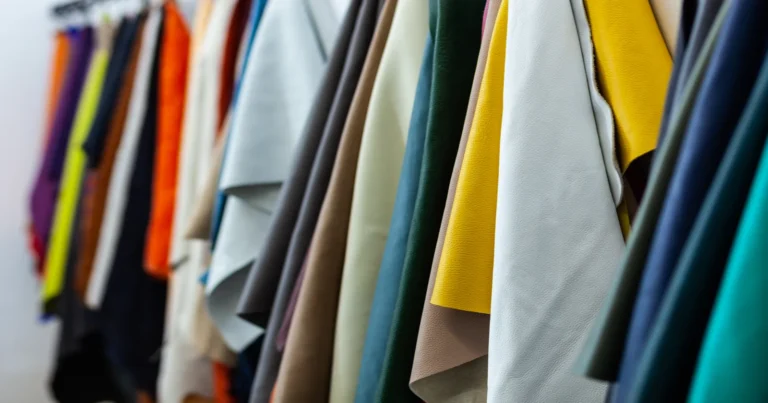
Different leather types suit different items. Here’s a quick guide to matching leather qualities with common uses:
For a good leather jacket, choose soft but tough hides:
Bags need leather that holds shape and resists scratches. Full-grain and high-quality top-grain are best. They stay sturdy and develop a patina as you use them. Thick leather adds structure to a backpack; thinner leather can be used for slouchy totes. Vegetable-tanned leather often makes great bags – it is strong and ages well. Some bags use embossed or pigmented leather for a uniform look and stain resistance (like travel luggage or everyday carry bags). Shell Cordovan or other exotic skins can make luxury clutches or accessories, adding shine and uniqueness.
Belts require stiffness and strength. Vegetable-tanned cowhide is ideal because it’s thick and will not stretch out. Full-grain or top-grain veg-tan belts last decades. Genuine leather belts (thinner hides) or bonded belts stretch and break sooner. A good belt might have two layers of leather stitched together for strength. For formal belts, smooth pigmented leather gives a clean finish. Casual belts often feature the rough hide side (suede or nubuck) or one with a visible grain. Avoid soft lambskin for belts; it won’t support heavy pant loops.
Shoe leather must resist moisture, scuffs, and bending. Full-grain leather, especially oiled or waxed (like pull-up leather), works well for boots. For dress shoes, high-quality top-grain calfskin shines up nicely. Nubuck and suede are stylish for chukka boots or casual shoes but get scuffed easily; protect them well. For hot weather shoes, look for leather that is tanned for breathability (soft, full-grain leather breathes better than thick slick leather). Insoles often use softer leather to absorb moisture. In any shoe, toe and heel areas benefit from extra-tough leather.
Furniture leather needs to be tough and stain-resistant. Most sofas use corrected-grain or pigmented leather with a protective coat (sometimes called “leather match”). Full-grain sofas exist but are premium. Top-grain with a slight finish is common for office chairs and cars. Fabric backs (the underside of top-grain) are sometimes bonded to a heavy frame. For upholstery, a semi-aniline finish balances natural look with ease of cleaning. Extremely cheap couches might use bonded leather on the outer panels (avoid if you want true leather quality).
In hot climates, prioritize breathability. Leather that is thinner and not heavily coated works best (goat or lamb). Lighter colors reflect heat; highly polished dark leather absorbs it. For very hot weather, open-weave or perforated leathers allow air flow (you might see this in car seats). In cold climates, thicker leather and wool-lined options excel. A thick full-grain jacket keeps out wind. Mink oil–treated leather sheds water and stands up to snow. Cold weather accessories like mittens often use thick suede or shearling (shearling is actually sheepskin with wool, extremely warm).
For slim wallets and straps, you want leather that won’t stretch out shape. Vegetable-tanned cowhide or full-grain goat leather are common. These won’t get limp. Smaller items can even use thinner leathers because they don’t bear heavy weight. Sheepskin or calfskin in small amounts adds a premium feel.
| Thickness | Best Uses |
|---|---|
| 1-2 oz (0.4-0.8mm) | Gloves, linings, lightweight garments |
| 3-4 oz (1.2-1.6mm) | Wallets, accessories, dress shoes |
| 5-6 oz (2.0-2.4mm) | Belts, holsters, heavy-duty boots |
| 7+ oz (2.8mm+) | Saddles, industrial applications |
Pro Tip: Italian leather jackets typically use 2-3oz hides for optimal drape, while American workwear favors 4-5oz for durability.
Matching the leather grade and treatment to the item ensures good performance. A cheap bonded leather bag will not handle heavy use. A soft lambskin jacket is wonderful to wear, but won’t protect you in a fall like thick cowhide would. Think about how the leather meets your needs – for example, a travel bag should use tough pigmented leather to shrug off scuffs, while a luxury purse might use aniline leather for beauty.
Understanding leather terms helps you talk knowledgeably about leather. Below are key definitions and common questions:
Q: How do I clean a leather sofa?
First, dust it with a soft cloth or vacuum with a brush attachment. For stains, use a damp cloth with mild soap (saddle soap or a bit of dish soap). Wipe gently and then dry with a clean cloth. Do a spot test first. Always finish by applying a leather conditioner to keep the couch supple.
Can I use water on leather?
A: Small amounts of water can be used for cleaning dirt, but leather doesn’t like soaking. Always use a barely damp cloth and dry quickly. Standing water can leave stains or cause mildew. After any cleaning with water, dry the leather with a towel and let it air dry fully.
Q: How do I remove stains from leather?
A: Blot spills immediately. For oil-based stains, sprinkle baking soda or cornstarch to absorb the oil (leave for a few hours, then brush off). For general stains, a mild soap solution can help. There are also specialized leather stain removers. For ink, rubbing alcohol on a cotton swab sometimes works – test first. If unsure, consult a professional. Always recondition after cleaning.
Q: How often should I condition a leather sofa?
Q: What is the best leather for a humid environment?
In high humidity, leather can attract mold if left damp. A good choice is pigmented leather with a finish, as it resists moisture penetration. Quick-drying full-grain with a thin coat or wax is also okay (just wipe off any water). Use dehumidifiers or keep fans on to prevent buildup. Avoid suede or bare aniline leather if you expect moisture, unless you apply a water-repellent treatment.
Q: Does leather fade in the sun?
Yes, prolonged exposure to sunlight can fade leather color, especially aniline and pigmented dye. Many protective finishes include UV inhibitors to slow this down. To keep leather vibrant, place it out of direct sun or use window tints and shade. Even indirect light over years causes some color change (patina) – this is normal in high-quality hides.
Q: Are all fake leathers cruelty-free?
Synthetic leathers (PU, PVC) are cruelty-free since no animal is used. However, new bio-based leathers like mushroom or pineapple are also cruelty-free. But check production methods – some manufacturers may use animal products in processing even for “vegan leather.” If cruelty-free is the goal, look for certifications or transparent brand policies.
Q: How do I care for suede and nubuck?
Suede and nubuck need special care: brush them with a suede brush regularly. For stains, use an eraser-like suede block. There are sprays that protect suede from water and dirt. Do not use conditioners meant for smooth leather; instead use a suede protector. Let them dry if they get damp, and store them away from humid or wet areas.
Q: Is leather good for the environment?
Leather is a byproduct of meat production, so it uses materials that might otherwise be wasted. High-quality, long-lasting leather can be eco-friendly compared to disposable synthetic alternatives. However, the tanning process can be chemically heavy. Choosing vegetable-tanned or responsibly produced leather reduces impact. Avoid cheap, short-lived leather items; a repairable, well-made leather product is often the greener choice.
Q: What should I do if my leather cracks?
Cracks mean the leather has dried out. First, condition it to hydrate the hide. For deeper cracks, a leather filler kit may help smooth them out, followed by dye. Prevention is key: regular conditioning keeps leather flexible. If the crack is very severe, the best solution is to replace that piece.
Q: How can I tell if leather is bonded?
Bonded leather often carries a sticker or label. You can also tell by touch and edge. Press on the surface: if it wrinkles like plastic, it’s likely bonded. The aroma of bonded leather may smell glue-like. Look at the edges: if you see layers separating or nothing like natural fibrous texture, it’s a sign of bonded material.
Can you fix peeling bonded leather?
Unfortunately, no – bonded leather’s plastic coating degrades irreversibly. Consider:
Why does my leather jacket feel sticky?
Caused by:
Leather is a rich and varied material. From the highest full-grain leather that ages into beauty, to affordable faux leathers, knowing the differences matters. You now understand how hides become leather through vegetable tanning or chrome tanning, and how finishes like aniline or pigmented coats change leather’s look. You see how to care for leather — simple cleaning, conditioning, and protecting steps go a long way. Remember how to spot real hides versus synthetics, and consider eco-friendly options if sustainability is key. Finally, pick the right leather for the job: tough cowhide for boots, soft lambskin for jackets, sturdy veg-tan for belts, and waterproof finishes for outdoor gear.
When you handle leather thoughtfully — whether choosing the grade for your next bag or maintaining your favorite jacket — you ensure it stays beautiful and lasts a lifetime. Use this guide as a reference for all things leather, and you will enjoy the confidence that comes from making informed, quality choices. Leather brings both luxury and durability; with the right knowledge, you can appreciate and preserve it at its very best.
IsItRealLeather began with one goal: to defend and promote authentic leather in a world full of cheap substitutes. We’re not a brand or manufacturer—we are a community-driven resource backed by writers, leather crafters, and passionate consumers from around the world.
Sign up, you’ll love hearing from us. We promise!